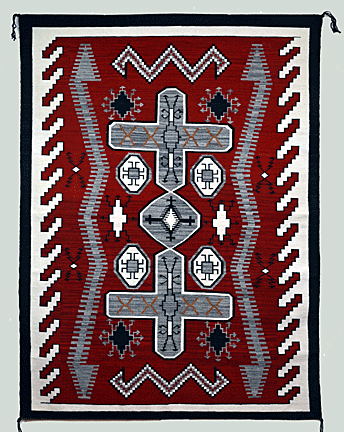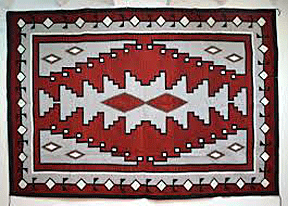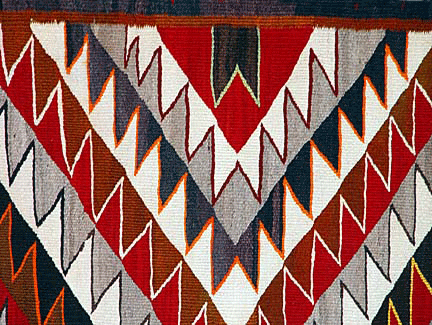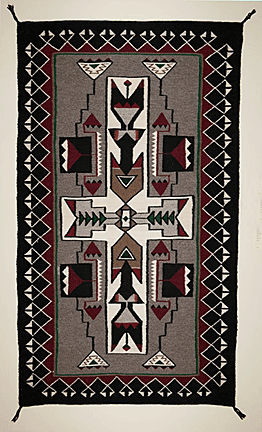Caring for Antique
Navajo Rugs
by Bob Brooke
 Even
relatively minor damages or stains on Navajo rugs may reduce their
market value by 80 percent compared to an identical rug in perfect
condition. So itís important to care for them correctly. Even
relatively minor damages or stains on Navajo rugs may reduce their
market value by 80 percent compared to an identical rug in perfect
condition. So itís important to care for them correctly.
A world of difference exists between the extremes of "repairs" and
"restoration."
"Repair" is the stabilization of a textile with any technique and
material which prevents further deterioration. "Restoration," on the
other hand, is any state of the art technique which renews a textile to
its original appearance.
For example, very good repairs may surpass very poor restorations in
quality. Itís the craftperson that matters. Reputation and history are
everything in the field of textile conservation. A rug could be further
damaged or diminished in value in the hands of an incompetent cleaning
or restoration person.
The Origins of Navajo Rug Weaving
Navajo blankets have been woven only since the 17th century. The Navajos
learned weaving techniques from the Pueblo Indians beginning with the
Pueblo Revolt of 1680 to 1692 when the Pueblo tribes organized to defeat
their Hispanic oppressors. This exchange of weaving knowledge occurred
when some Pueblo Indians sought refuge with their Navajo neighbors. The
Pueblo weaving tradition descended from their ancestors, the Anasazi.
 The
earliest Anasazi textile fragments have been excavated from 2nd-century
sites in on the Grand Gulch of southeast Utah. These fragments indicated
that the Anasazi used cotton, prior to the introduction of sheep into
the Southwest by the Spaniards, and only natural browns, beige, black,
and gray to color them. The
earliest Anasazi textile fragments have been excavated from 2nd-century
sites in on the Grand Gulch of southeast Utah. These fragments indicated
that the Anasazi used cotton, prior to the introduction of sheep into
the Southwest by the Spaniards, and only natural browns, beige, black,
and gray to color them.
Navajo rugs have been woven only since the mid-19th century when Anglo
and Hispanic traders developed this craft for East Coast markets. These
first Navajo rugs are a heftier version of their blankets. They wove
designs provided by early trading post proprietors to suit this market.
In fact, the proprietors often copied designs from the geometric
Caucasian Oriental rugs that were popular at the time.
 Unfortunately,
the Navajo didnít systematize their rug craft to obtain consistently
high quality wools or yarns. Pioneer settlers and the U.S. Army often
disrupted their culture. The breeds of sheep they raised varied and
pastures constantly suffered from overgrazing, so the wool supply was
erratic and its quality suffered. In addition, there were fewer Navajo
weavers compared to Oriental ones, and they occupied a limited area in
the Southwest. Unfortunately,
the Navajo didnít systematize their rug craft to obtain consistently
high quality wools or yarns. Pioneer settlers and the U.S. Army often
disrupted their culture. The breeds of sheep they raised varied and
pastures constantly suffered from overgrazing, so the wool supply was
erratic and its quality suffered. In addition, there were fewer Navajo
weavers compared to Oriental ones, and they occupied a limited area in
the Southwest.
Homespun yarns vary in tightness of spin. The Navajo cleaned and combed
their wool using a variety of methods so characteristics from batch to
batch were unpredictable: To further complicate matters, they also used
various commercial yarns. The most well-known materials are Bayeta
(Hispanic), Saxony (commercially yarns produced in Germany) Germantown
(commercial yarns produced near Philadelphia). So reproducing these
yarns presents a challenge for the Navajo rug restorer, who often relies
on fragments of these textiles which they can cannibalize for their
yarns.
Cleaning Navajo Rugs
Bled dyes, especially the reds, are a common problem with Navajo rugs:
These are aniline dyes, such as the Rit brand dyes, and arenít usually
colorfast. Other dyes can also bleed. Unlike most good quality Oriental
rugs, a red Navajo rug cannot simply be washed with a mild soap out on
the driveway using a hose since the red will bleed to pink. If none of
the wools used in a Navajo rug are dyed wools, it can be washed. Navajo
rugs like these are fairly common.
 However,
most blacks have been over dyed for consistent color. A test should be
tried on a small area first, gently scrubbing the rug in the direction
of the spin and weave. Itís important not to unravel or unbraid these
soft yarns. After copious rinsing, the rug should be wet vacuumed until
nearly dry. However,
most blacks have been over dyed for consistent color. A test should be
tried on a small area first, gently scrubbing the rug in the direction
of the spin and weave. Itís important not to unravel or unbraid these
soft yarns. After copious rinsing, the rug should be wet vacuumed until
nearly dry.
Since Navajo chemical dye technology isnít as sophisticated as Oriental
chemical dye technology, itís frankly best to leave the cleaning of a
Navajo rug to a professional who has worked with them before. Always ask
if the company has cleaned Navajo rugs before arranging to leave one
with them. While Oriental rug dealerships often employ repair persons
and a few also deal with Navajo rugs, some of the technology does
translate between Oriental and Navajo. But it pays to be sure.
Navajo rugs, which also have problems with chewing gum, molds which turn
white wools dirty gray, food stains which can grow molds which in turn
corrode fibers, and pet urine stains, should also be trusted to an
experienced professional. Gum and urine are difficult to remove without
ruining the colors or fibers during the cleaning process.
Since Navajo rug values are relatively high, itís important to find a
qualified Navajo rug cleaner.
To read
more of my articles, please
visit
my Web site.
<
Back to Caring for Your Collections
Archives
Next Article >
|
